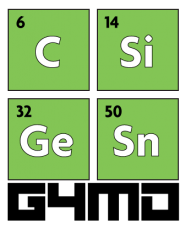Modeling Semiconductor Heteroepitaxy @UNIMIB

The Materials Science Department of the University of Milano-Bicocca (UNIMIB) hosts a theoretical/computational unit focusing on multiscale modeling of semiconductor heteroepitaxy. In particular, the group has decades-long expertise in simulating integration of Ge and SiGe alloys on silicon.
Large scale, continuum models tackling the morphological evolution of strained films, also in the presence of extended defects, have been introduced by the group and shown to closely capture the experimental observations, e.g. in terms of film roughness, island formation, cross-hatch patterns, compositional profiles. The developed computational approach is well suited for investigating both close-to-equilibrium and kinetically-limited growth.

The group is theoretical but applied, as demonstrated by several international collaborations with both academic and industrial epitaxy laboratories: models are developed aiming at helping experimental colleagues interpreting data and developing better growth strategies.
Expertise in atomic-scale calculations (e.g. classical and ab initio MD) is also present within the unit and exploited in the investigation of some key microscopic quantities (surface energies, dislocation core structures, electronic states) which cannot be directly addressed by continuum approaches.
Contacts:
Prof. Francesco Montalenti
Email: This email address is being protected from spambots. You need JavaScript enabled to view it.
Optica Spectroscopy of Semiconductors @UNIMIB

The LAboratory of optical Spectroscopy of SEMiconductors - LASSEM is an experimental research group that focuses on emerging phenomena in condensed matter physics. LASSEM is specifically interested in understanding the fundamental behavior of quantum structures based on group IV materials and their implications in fields like microelectronics, optoelectronics and spintronics.
The research efforts leverage a long-standing expertise in optical techniques. LASSEM has addressed electronic and vibrational properties of Ge and SiGe heterostructures and investigated spin-dependent phenomena in Ge and lately in GeSn binary alloys.

The access to a broad spectral window (UV-to-IR) and the use of optical methods ranging from photoluminescence to absorption and Raman spectroscopy enable LASSEM to gather central insights into carrier and lattice dynamics.
Acentral goal of the research of LASSEM is to understand and control the fundamental mechanisms governing coherent phenomena and spin relaxation in group IV materials. The unique approach based on the optical accessibility of spins is a key advantage, which is expected to lead to novel functionalities and concepts for future device architectures.
Contacts:
Prof. Fabio Pezzoli
Email: This email address is being protected from spambots. You need JavaScript enabled to view it.

